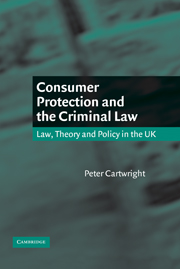Book contents
- Frontmatter
- Contents
- Preface
- Acknowledgements
- List of abbreviations
- 1 Consumer protection rationales
- 2 Techniques of regulation
- 3 The role of criminal sanctions in consumer protection
- 4 The use of the criminal law
- 5 Consumers and safety: the protection of physical integrity
- 6 The protection of economic interests
- 7 The enforcement of regulatory consumer law
- 8 Conclusions
- Index
5 - Consumers and safety: the protection of physical integrity
Published online by Cambridge University Press: 24 June 2009
- Frontmatter
- Contents
- Preface
- Acknowledgements
- List of abbreviations
- 1 Consumer protection rationales
- 2 Techniques of regulation
- 3 The role of criminal sanctions in consumer protection
- 4 The use of the criminal law
- 5 Consumers and safety: the protection of physical integrity
- 6 The protection of economic interests
- 7 The enforcement of regulatory consumer law
- 8 Conclusions
- Index
Summary
Introduction
Probably the most serious threat to consumers is to their health and safety, and few would dispute that the law has a role to play in controlling the supply of dangerous products. However, behind this broad consensus there are many areas of disagreement. First, it is unclear precisely on what basis the law should provide this protection. If we analyse the law in terms of market failure we might conclude that dangerous products should be controlled for two main reasons: first, because consumers tend to be unaware of the threats that such products pose (information failure), and secondly, because dangerous products pose threats to third parties (they create externalities). On those bases, product safety regulation can be justified from an economic perspective. However, we might go beyond this analysis and argue that even if consumers were properly informed about the risks posed by a product, and there was no risk of the product affecting third parties, the law should nevertheless forbid the supply of that product. Such a conclusion is sometimes rejected as unwarranted paternalism, but, as we saw in chapter 1, there are arguments for protecting consumers from themselves. There have been attempts to argue that where the state imposes mandatory product safety standards this may not be classified as paternalism, but as the state giving effect to citizens' wishes that someone make a judgement about safety on their behalf. The persuasiveness of this is considered below.
- Type
- Chapter
- Information
- Consumer Protection and the Criminal LawLaw, Theory, and Policy in the UK, pp. 126 - 155Publisher: Cambridge University PressPrint publication year: 2001



